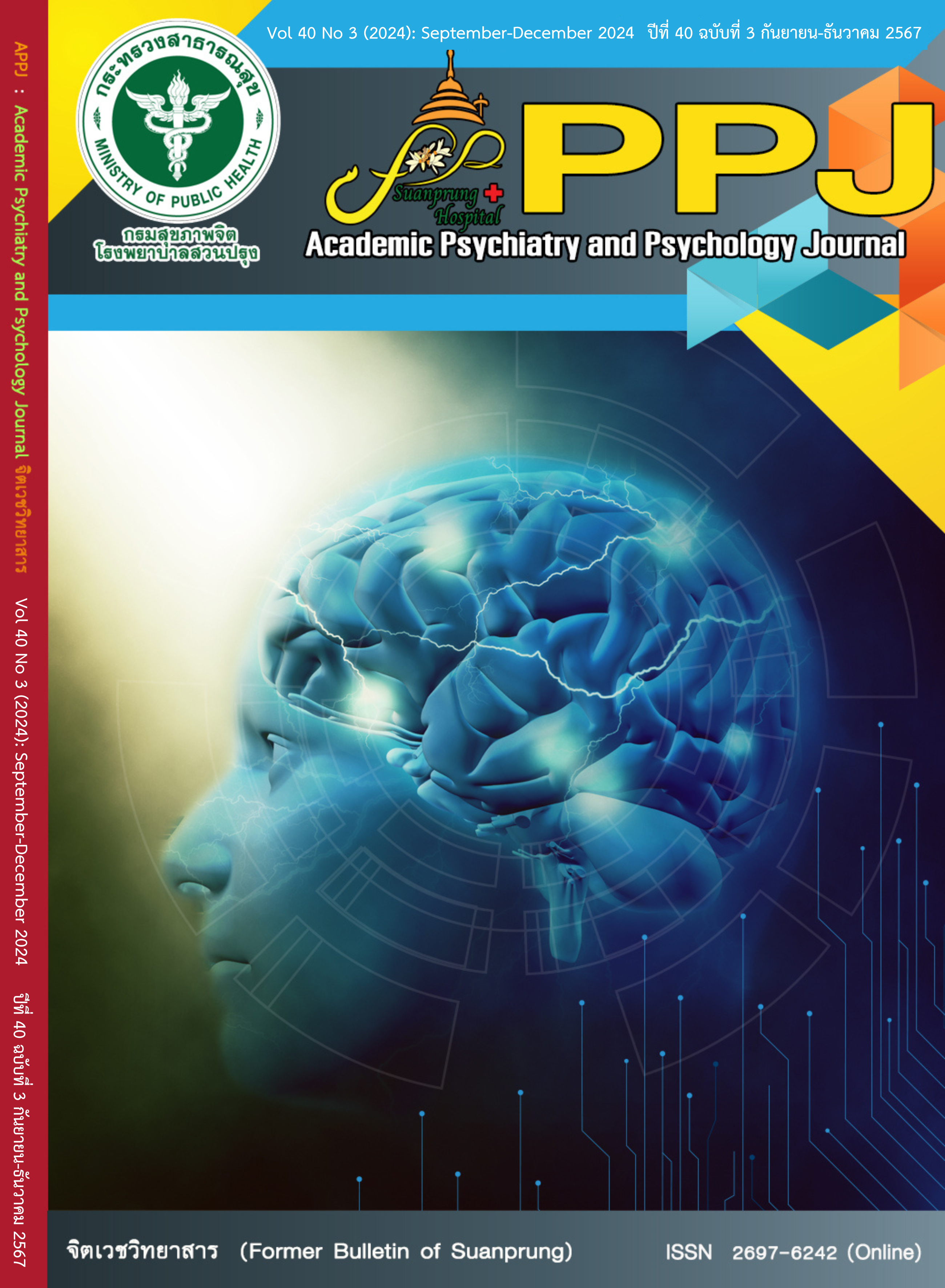Correlations between internalized stigma of persons with amphetamine dependence in rehabilitation wards การรับรู้การถูกตีตราของผู้ติดแอมเฟตามีนในระยะฟื้นฟูสมรรถภาพ
Main Article Content
Abstract
Objectives: The purposes of this study were to assess the internalized stigma and to examine the correlation between factors and the internalized stigma.
Methods: A cross-sectional study was conducted. Data were gathered from 90 eligible persons in the rehabilitation wards of Thanyarak Khonkaen Hospital between May 22nd and September 30th, 2023. This study utilized personal questionnaires and the Internalized Stigma of Substance Abuse Scale as data collection instruments. Descriptive statistics were used, and multiple regression analyses were performed to examine correlations.
Results: The majority of the participants were male, aged between 20 and 29 years, with rehabilitation durations ranging from 21 to 30 days. The frequency of amphetamine use was 3 to 4 days per week. The quantity of amphetamine use was fewer than 5 pills. Half of persons with amphetamine dependence in rehabilitation wards exhibited mild levels of internalized stiga. Analysis of the correlations between factors and internalized stigma revealed that the quantity of amphetamine use significantly correlates with internalized stigma (P-value = 0.031).
Conclusion: Persons with amphetamine dependence in rehabilitation wards exhibited mild levels of internalized stigma. There was correlation between the quantity of amphetamine use and the level of internalized stigma . It is recommended that therapeutic interventions should be developed to reduce internalized stigma among amphetamine-dependent persons undergoing rehabilitation.
Article Details

This work is licensed under a Creative Commons Attribution-NonCommercial-NoDerivatives 4.0 International License.
บทความหลังผ่านการปรับแก้จากกองบรรณาธิการแล้ว เป็นลิขสิทธ์ของวารสารจิตเวชวิทยาสาร โรงพยาบาลสวนปรุง กรมสุขภาพจิต กระทรวงสาธารณสุข ห้ามเผยแพร่เพื่อประโยชน์ทางการค้าโดยไม่ได้รับอนุญาต แต่อนุญาตให้เผยแพร่บทความดังกล่าวเพื่อประโยชน์ทางการศึกษาแก่ประชาชนทั่วไป ทั้งนี้กองบรรณาธิการไม่จำเป็นต้องเห็นด้วยกับบทความหรือข้อคิดเห็นใดๆ ที่ปรากฏในวารสารสวนปรุง
References
WDR 2021_Booklet 4 [Internet]. United Nations: Office on Drugs and Crime. [cited 2022 Nov 5]. Available from: //www.unodc.org/unodc/en/data-and-analysis/wdr-2021_booklet-4.html
Annual report 2564.pdf [Internet]. [cited 2022 Nov 6]. Available from: https://www.oncb.go.th/EBookLibrary/annual%20report%202564.pdf
Han L, Jia CX. Treatments, Perceived Stigma, and Employment Outcomes among Substance Abusers in China. Healthcare. 2022 Jan;10(1):130.
Stigma, Discrimination & Substance Use.pdf [Internet]. [cited 2022 Nov 7]. Available from: https://www.toronto.ca/wp-content/uploads/2018/01/93e2 stigmadiscrim_rep_2010_aoda.pdf
Ahern J, Stuber J, Galea S. Stigma, discrimination and the health of illicit drug users. Drug and alcohol dependence. 2007;88(2–3):188–96.
Duangjampha B, Kanato M. A comparative study on social stigma regarding illicit drugs between drug users and general population in Nampong district, Khon Kaen Province. Community Health Dev. 2015;3(2):1–12.
Teeters JB, Lancaster CL, Brown DG, Back SE. Substance use disorders in military veterans: prevalence and treatment challenges. Dove Press. 2017;8:69–77.
Nunsoongnern S, Rodcumdee B, Suktrakul S. Selected Factors Related to Perceived Stigma Patients with Amphetamine Dependence. Royal Thai Navy Medical Journal. 2019 Apr 30;46(1):1–17.
Vatanasin D, Dallas JC. Factors Predicting Self-stigma among Youths Receiving
Substance Abuse Treatment. Pacific Rim International Journal of Nursing Research.
Luoma JB, Kohlenberg BS, Hayes SC, Bunting K, Rye AK. Reducing self-stigma in substance abuse through acceptance and commitment therapy: Model, manual development, and pilot outcomes. Addict Res Theory. 2008;16(2):149–65.
Room R. Stigma, social inequality and alcohol and drug use. Drug Alcohol Rev. 2005 Mar;24(2):143–55.
Link BG, Phelan JC. Conceptualizing Stigma. Annual Review of Sociology. 2001 Aug 1;27(Volume 27, 2001):363–85.
Elkalla IHR, El-Gilany AH, Baklola M, Terra M, Aboeldahab M, Sayed SE, et al. Assessing self-stigma levels and associated factors among substance use disorder patients at two selected psychiatric hospitals in Egypt: a cross-sectional study. BMC Psychiatry. 2023 Aug 15;23(1):592.
Muncan B, Walters SM, Ezell J, Ompad DC. “They look at us like junkies”: influences of drug use stigma on the healthcare engagement of people who inject drugs in New York City. Harm Reduction Journal. 2020 Jul 31;17(1):53.
Wong-Anuchit C. Internalized Stigma of Substance Abuse Scale (ISSA: Thai Version). Maha Sarakham: Faculty of Nursing, Mahasarakham University; 2022.
Luoma JB, O’Hair AK, Kohlenberg BS, Hayes SC, Fletcher L. The Development and Psychometric Properties of a New Measure of Perceived Stigma Toward Substance Users. Subst Use Misuse. 2010;45(1–2):47–57.
Yamane T. Statistics: An Introductory Analysis. 3rd ed. New York: Harper and Row; 1973.

